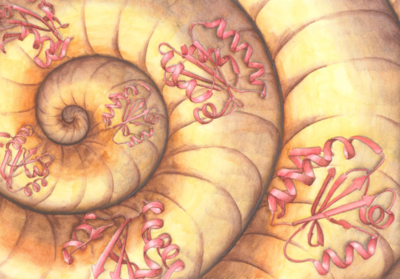Art:Thioredoxin: A small protein with a radical role
From Proteopedia
Behind the Artwork and the Protein Structure
This artwork was created by student Anna Valchanova, from the Stephen Perse School. This watercolour depicts the thioredoxin protein structure from F. hepatica along with the host snail. The repetition of the thioredoxin protein structure with increasing size reflects the parasite’s growth and development inside the snail, with the watery texture conveying the aquatic environment of the host. This image is that of Thioredoxin, a small protein with a vital role in many organisms. The image depicts the structure of Thioredoxin from the liver fluke parasite, along with an image of the freshwater snails that are hosts for these organisms.
View in 3D or go to PDB structure 2vim [1]
Thioredoxin
During many metabolic processes, molecules are produced which are short of electrons. These molecules, called free radicals, will scavenge electrons from anywhere they can, potentially damaging other cellular molecules in the process. Thioredoxin (Trx) is an antioxidant that aids in the removal of these potentially harmful free radicals. Trx is a small protein molecule, typically around 12 kDa in size, found in almost all organisms. There are two human variants (Trx1 and Trx2), however other organisms have different numbers of Trx proteins. These antioxidant proteins have many different substrates, usually other proteins with important functions in the cell. For example, Trx is involved in DNA replication and repair, preventing the release of free radicals in this process, while it also protects insulin from oxidation.
Thioredoxin reduction - more than just a FAD
Trx prevents free radical formation by the donation of electrons to molecules that have lost them through oxidation. In order to do this more than once, Trx must therefore be resupplied with more electrons, a process catalysed by thioredoxin reductase (TrxR). The reaction involves a multistep transfer of electrons from the initial electron-donor, NADPH, via Flavin adenine dinucleotide (FAD) and finally to two conserved cysteine residues in Trx.
The TrxR reaction mechanism is different between mammals and bacteria, thus this protein has been identified as a potential antibiotic target. It is also thought that Trx may be important in slowing the ageing process, due to the the reduction of harmful free radicals in cells. While there is limited direct evidence to support this theory, one study suggested that overexpression of Trx in mice lead to an increase in life expectancy. In a world with an continuously ageing population, this would be an attractive drug target for pharmaceutical companies.
General structure of Thioredoxin
The structure of Trx is composed of five core beta strands, surrounded by four alpha helices. This Thioredoxin fold is common to thiol-dependent antioxidants and contains a conserved dithiol-disulphide active site, located at the beginning of the α2-helix. This site contains a conserved CXXC sequence motif containing the two cysteine residues that are key to the mechanism of Trx.
Fasciolids
The thioredoxin structure in this artwork (PDBe.org/2vim) is from Fasciola hepatica, the liver fluke parasite responsible for Fasciolisis. The intermediate hosts of the F. hepatica organisms are air-breathing, freshwater snails of the Lymnaeidae family. While the resulting disease is generally more common in livestock than in humans, there is an increasing interest in this disease as the number of cases in humans has increased, particularly in South America, Egypt and Iran. Treatment of the disease is mainly focused on developing vaccines for the host livestock animals, thus breaking the F. Hepatica life cycle and preventing transmission through to humans.
Explore the scientific publication
- ↑ Line K, Isupov MN, Garcia-Rodriguez E, Maggioli G, Parra F, Littlechild JA. The Fasciola hepatica thioredoxin: High resolution structure reveals two oxidation states. Mol Biochem Parasitol. 2008 Sep;161(1):44-8. Epub 2008 Jun 21. PMID:18620002 doi:10.1016/j.molbiopara.2008.06.009

